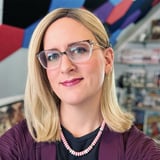Summary
How do you keep human needs balanced with those of a business, especially when the business is the largest power and gas company in the country? Gretchen Anderson is the Head of Design at PG&E, and she talks about how she's scaling what she's learned across an enterprise-level organization.
Key Insights
-
•
Enterprise environments often prefer predictable A-to-B-to-C workflows, which conflict with user-centered design's iterative, exploratory nature.
-
•
Features like satellite asset maps for field workers may never emerge without intentional user-centered design involvement.
-
•
Pair design—with peers across disciplines or perspectives—accelerates ideation and produces more resilient design solutions.
-
•
Designers often feel isolated and undervalued due to paranoia and lack of inclusion; proactive creation and sharing of deliverables helps secure their place at the table.
-
•
Design systems and pattern libraries are essential guardrails but require ambassadors or design operators to help teams adapt them effectively.
-
•
Designers’ unique fingerprints and problem-solving styles mean that even with the same inputs, outputs can validly differ among designers.
-
•
Storytelling and prototyping are powerful tools to influence stakeholders and shift conversations toward productive outcomes.
-
•
UX debt is sometimes necessary and should be managed collaboratively between designers, tech leads, and product owners as part of the release strategy.
-
•
Building authentic, facilitated relationships across the organization reduces designer isolation and elevates the perceived value of design.
-
•
Human-centered design includes designing the experience of working with the design team, not just the end-user product experience.
Notable Quotes
"Silicon Valley feels fast, but when the grid goes down, it can be catastrophic."
"That’s the kind of feature that never would have made it to the top of anyone’s backlog without design."
"Working in pixels, we still have fingerprints. You all have a style. That’s a great thing."
"Designers can be really paranoid and very precious."
"Pair design is about two perspectives coming together as peers to quickly try and evaluate ideas."
"Invite yourself to the table by bringing actual deliverables, like storyboards and prototypes."
"Prototyping is not about usability, it’s about exploring the idea."
"No wiki in the world is as good as somebody who can come and tell you how to bend the rules a little bit."
"I see designers fall back on being the defender of the user like a union boss, but that’s not your only responsibility."
"Human-centered design is not just about your end users, it’s about the humans in your team."
Or choose a question:















More Videos

"Our shift is structural, not because of personalities — it was needed to influence earlier, more business-centric decisions."
Nalini KotamrajuResearch After UX
March 25, 2024

"Not belonging anywhere meant that I had access everywhere."
Dean BroadleyNot Black Enough to be White
January 8, 2024

"If you’re not doing the work of addressing your own pain, you won’t be effective in helping others."
Denise Jacobs Nancy Douyon Renee Reid Lisa WelchmanInteractive Keynote: Social Change by Design
January 8, 2024

"Failure isn’t discouraging; it’s an opportunity to learn and improve your approach."
Kim Fellman CohenMeasuring the Designer Experience
October 23, 2019

"Good design is honest and yes, the Jewel e-cigarette will honestly kill you."
George AyeThat Quiet Little Voice: When Design and Ethics Collide
November 16, 2022

"Getting exact endorsement from the top helps your cause immensely."
Nathan CurtisBeyond the Toolkit: Spreading a System Across People & Products
June 9, 2016

"We are building cross-product research capabilities to curate a holistic understanding of agents across all workflows and touchpoints."
Greg PetroffThe Compass Mission
March 10, 2021

"We have this collective superpower navigating the breadth and depth of human experience across cultures."
Chloe Amos-EdkinsA Cultural Approach: Research in the Context of Glocalisation
March 27, 2023

"Agile can feel like a cult, but the data helps show it’s working and not just a belief system."
Mackenzie Cockram Sara Branco Cunha Ian FranklinIntegrating Qualitative and Quantitative Research from Discovery to Live
December 16, 2022
















